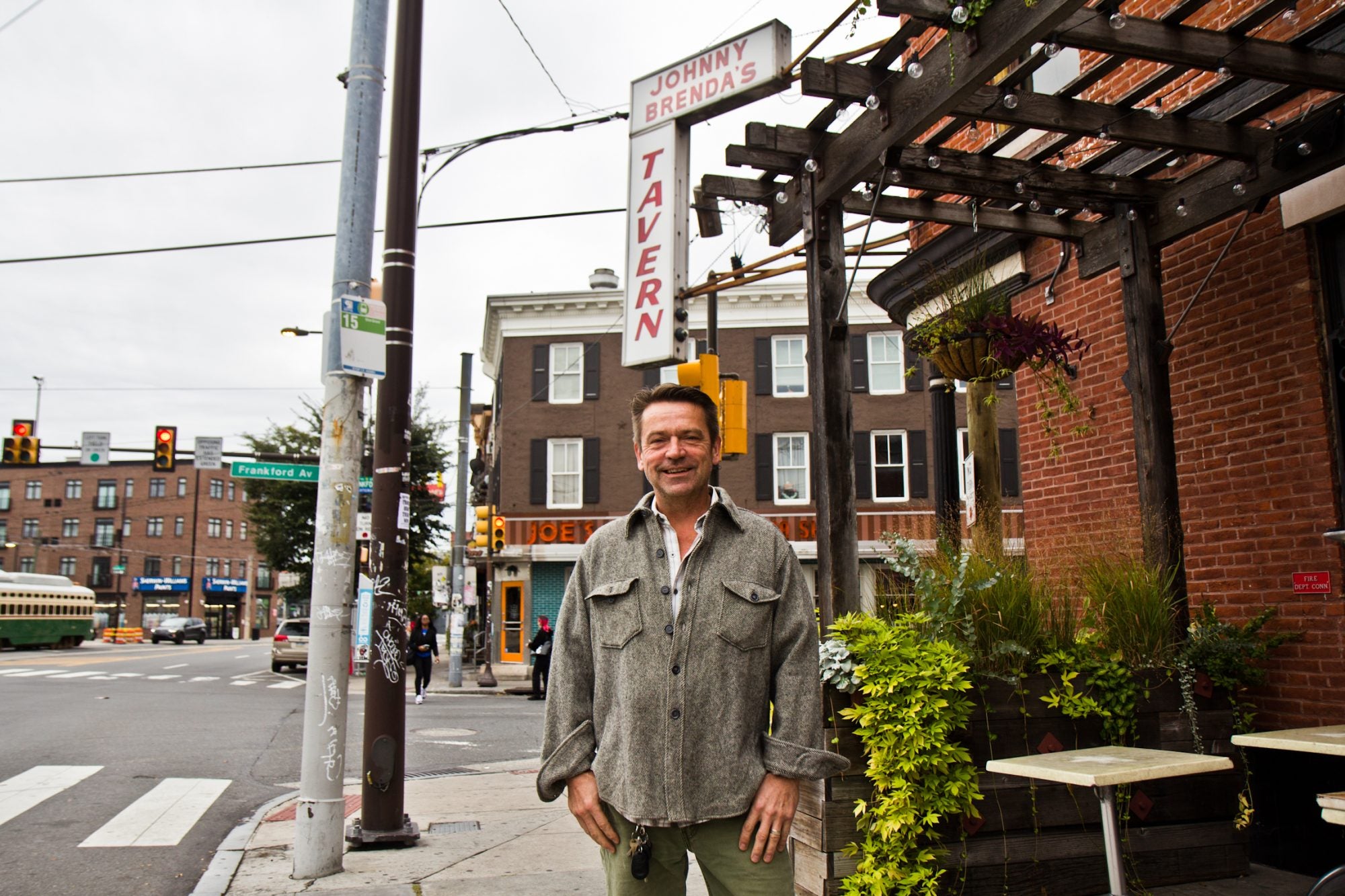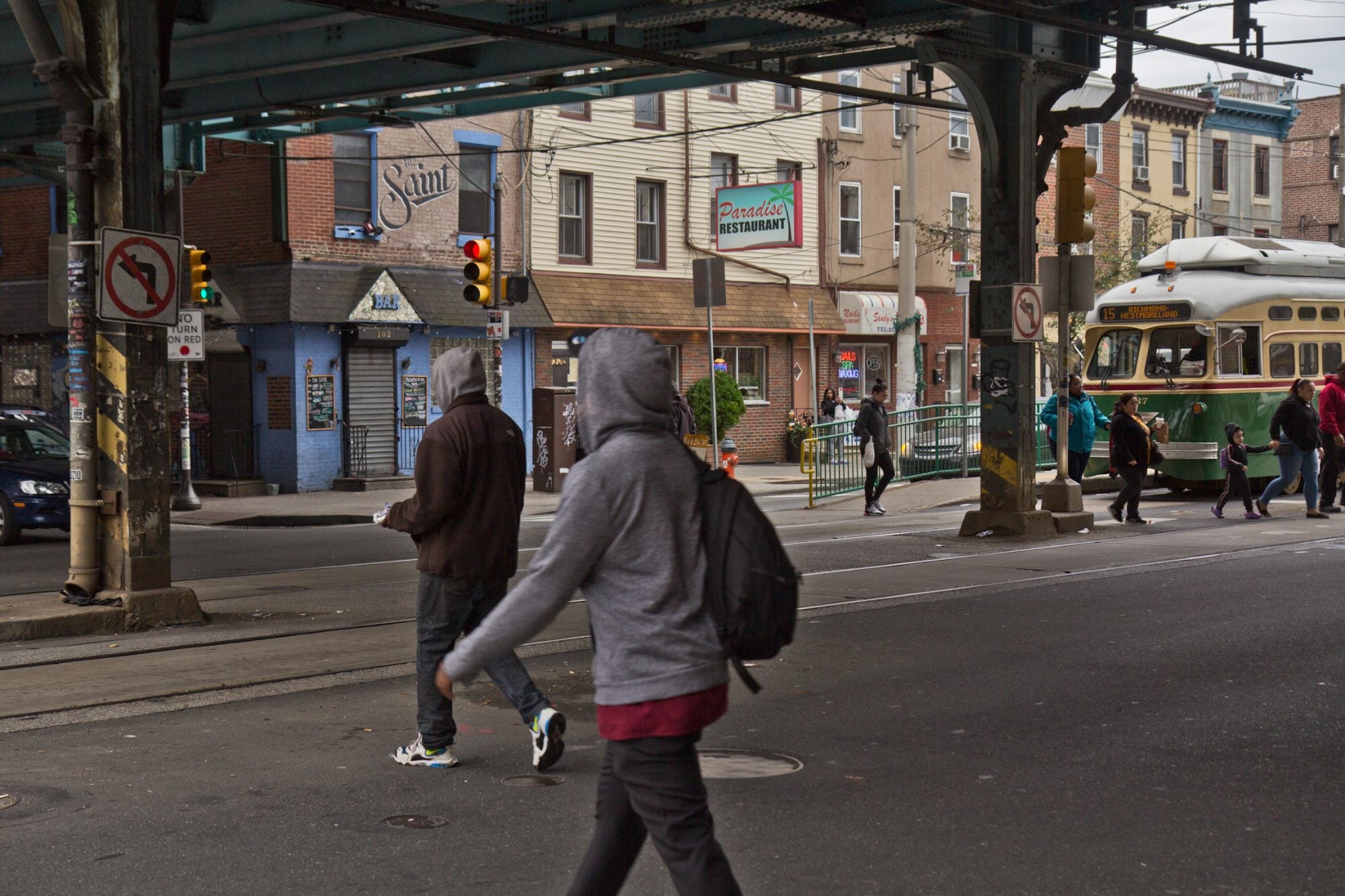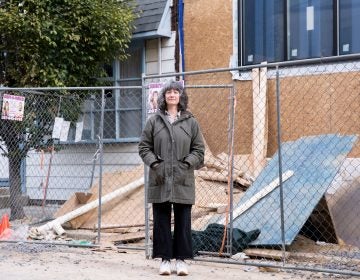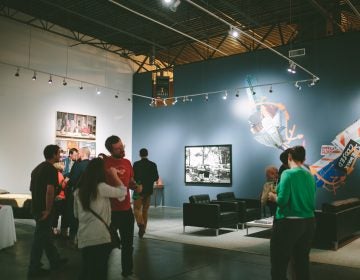Despite loud opposition, business improvement districts for Fishtown, South Philly advance
Business owners in Fishtown and South Philadelphia could soon be paying an assessment for new services.

Johny Brenda’s at Girad and Frankford Avenues in Fishtown. (Kimberly Paynter/WHYY)
The white and red Johnny Brenda’s sign is one of only a few things that hasn’t changed on Frankford Avenue in the 15 years since Paul Kimport and William Reed bought the Fishtown bar.
Another thing is the trash.
Though property values are soaring and high-end tenants like La Colombe and Lululemon have moved onto the busy commercial avenue, litter remains a constant presence.
“It’s a community problem. We need to clean it up. It’s unsanitary and unsightly,” Kimport said, mentioning that there often needles and other “dangerous” items on neighborhood streets.
Kimport is one of a group of Fishtown property owners now pushing to create a business improvement district (BID) in the growing neighborhood.
He and his allies believe the creation of the assessment-funded organization could help address issues like street cleaning that individual shopkeepers can’t handle on their own. The recent success of Frankford Avenue can help buoy the fortunes of the other commercial corridors, he argues.
“We can organize and have the capacity to address these problems, neighborhood-wide,” Kimport said.
The BID would have a $544,000 annual budget, derived from assessments charged to commercial property owners at .18% of their property’s assessed value.
The money would go towards cleaning and maintaining the streets and public spaces, with a special emphasis on the area around the Girard Station on the Market-Frankford line.
Kimport says he has buy-in from many other property owners, but at City Council’s Rules Committee hearing on Wednesday, opponents denounced the idea as anti-democratic and unnecessary.
Murat Aritan told the Rules Committee that he owns a building right next to Johnny Brenda’s and that he only just learned about the BID effort. He said he’s canvassed almost 30 property owners and that almost none of them had heard about it.
Aritan said that the services proposed by the BID should already be provided by the city, with the tax dollars the owners — and everyone else — already pay.
“I didn’t elect him, I didn’t elect Paul to be Fishtown’s mayor — he’s Johnny Brenda and he’s the one pushing this through because of his business and the chaos he creates on his corner,” said Aritan. “All these mom and pop shops aren’t represented by him, he doesn’t speak for us.”
Aritan and his supporters said they fear that businesses further up the corridors would see fewer benefits from the proposed BID.
But there are an array of owners who support Kimport’s efforts. Roland Kassis, the developer behind Frankford’s super La Colombe, Frankford Hall and other large commercial properties on the corridor, told PlanPhilly that he fully supports the plan.
On the other end of the spectrum, Bianca DePietro, who owns Toile, a small fashion atelier shop, spoke in favor of the BID.
“We’ve been trying for so many years to do so many things we can’t get done,” said DePietro. “I work 15 hour days and run everything by myself. There’s only so many things I can do in the hours of a day, so the BID would definitely help me out, and a lot of other business owners in Fishtown.”

Fishtown is not the first Philadelphia neighborhood divided by a proposed business improvement district. Nor will it be the last.
As commercial corridors across the city experience newfound and often fragile renaissances, BIDs are growing in popularity. But not without conflict.
Scholars of urban inequality argue that BIDs represent the privatization of what should be public services, hoarding privilege in areas that are already more economically successful. Other opponents say they are simply unfair — property owners already pay taxes. Why should they be subject to a second surcharge for what should be public services?
Opponents have proven their mettle in the recent defeat of a proposed Callowhill Business Improvement District, while previous proposals around Temple and in the Italian Market have been overwhelmed by backlash as well.
Now a new wave of Philadelphia BIDs face an uncertain future. Thanks to recent changes in the enabling legislation in Harrisburg, opponents have the advantage of only needing to rally over a third of affected property owners to vote down a BID.
South Philly Market District
Another BID proposal that came under fire Wednesday was the latest iteration of an Italian Market service organization.
Three years ago, attempts to organize a business improvement district around 9th Street went down to defeat. Many veteran store owners felt that the effort was intended to gentrify the popular outdoor market, while Latinx business owners to the south of Washington Avenue felt alienated by the campaign’s association with older Italian businesses.
But BID proponents have long argued that the market’s small vendors are suffering due to increased competition from new grocery stores and online shopping. They feel that giving the market a facelift, and regular cleaning will ensure its future.
“At this point, 9th Street, Washington Avenue, and Christian Street are one of the last unmanaged commercial corridors in the city, in terms of not having either a CDC or a BID,” said Eugene Desyatnik, president of the Bella Vista Neighbors Association and one of the most prominent advocates of the effort.
Desyatnik and his allies, like Vern Anastasio, say that the BID is necessary to revive the flagging fortunes of the market.
They point out the businesses that have recently closed — Monsú and Los Amigos Market — and argue that stronger corridor management would lead to better retail retention and fewer vacancies.
“Today the area is littered with blight: Boarded up windows, empty storefronts, almost every month another business closes,” Anastasio told the Rules Committee. “Litter, trash, vacancy, filth are almost everywhere.”
To assuage the concerns of opponents of the previous BID, the boundaries of the proposed district have been shrunk. The BID’s budget would be $400,000 annually, paid for by a surcharge of .2% of a property’s assessed value.
But opponents crowded the Rules Committee hearing, waving signs reading, “We oppose the plan” and “No South Philly Market BID.”
“As a small businessman, the city is already in my pocket for at least eight different licenses and fees,” said Barry Wilepsky, a small business owner who would be covered by the proposed BID. “I understand this wouldn’t go to the city. But Vern says its dues and, well, if its dues, I don’t want to join.”
After the Rules Committee passed both bills, a 45-day voting period begins where owners can vote to oppose by mailing in their ballots. If either one-third of the properties or properties equivalent to one-third of the value of the combined properties, vote to oppose the BIDs will be defeated.

That’s exactly what happened in Callowhill earlier this year.
The Chinatown Business Improvement District
In September, a BID proposed for Callowhill, backed by the Callowhill Neighborhood Association and the developer Arts and Crafts Holdings LLC, went down to defeat with 46% of affected property owners voting against it.
The effort met its match through a combination of longtime neighborhood opponents, who had organized to defeat a similar proposal in 2012, and the Philadelphia Chinatown Development Corporation. The PCDC saw the proposal as an incursion into an area that houses many of the community’s important institutions and the backend light industry for the restaurants of the central neighborhood.
During the battle over the Callowhill Business Improvement District, the Philadelphia Chinatown Development Corporation proposed its own BID.
The proposed district would encompass much of the same area.
Now PCDC has obtained a $50,000 grant from the city’s Commerce Department to more thoroughly craft the proposal.
Kelly Edwards, who leads the Callowhill BID effort with Arts and Crafts Holdings, would not comment on the rival BID effort.
John Chin of the Philadelphia Chinatown Development Corporation said that he thought his organization could succeed where the Callowhill group failed.
“PCDC has done neighborhood plans in the past, and we’ve been very successful in bringing people together,” said Chin.
“I think we’ve always said there needs to be a lot more engagement with the neighborhood,” said Chin. “It’s a very diverse, and not just racially or ethically. There’s so many different players in the neighborhood, light manufacturing, small business owners. That’s what makes a BID process successful, bringing people together.”
Many of the property owners who opposed the BID did so because residential property owners would be hit with fee assessments too. Chin said that his group’s effort would target commercial property owners only.
For Paul Levy, the head of the Center City District, the inclusion of residential properties can cause big problems for BID proponents, because the interests of business owners and the interests of residents don’t always overlap. It also helps when there is a clearly defined group of owners that are not riven by factions between the older property owners and newer ones, a fate that helped sink both Callowhill and the old 9th Street proposal.
The other issue emerging BIDs face is backlash against property tax increases and uncertain assessments.
“We’ve seen a steady increase in real estate taxes in recent years,” said Levy. “The whole argument was, well, these are the added value, the added services you’ll get. But because so many people’s assessments are going upwards, I think there’s a lot more sensitivity to it now than there was 10 years ago, or 15 years ago.”
WHYY is your source for fact-based, in-depth journalism and information. As a nonprofit organization, we rely on financial support from readers like you. Please give today.







